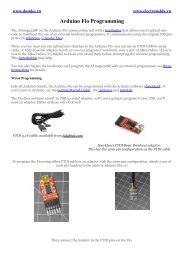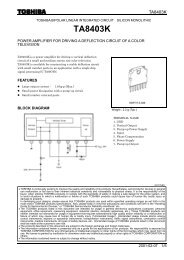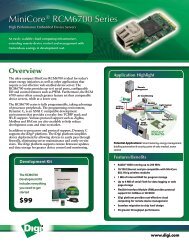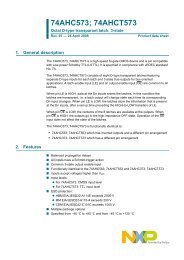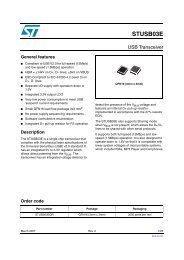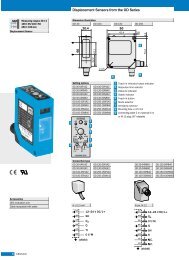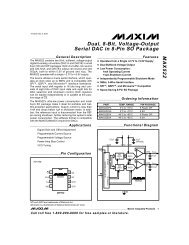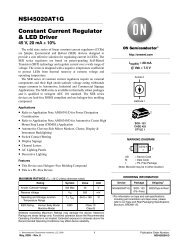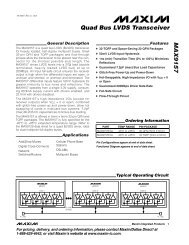ADM690-ADM695 Microprocessor Supervisory ... - Analog Devices
ADM690-ADM695 Microprocessor Supervisory ... - Analog Devices
ADM690-ADM695 Microprocessor Supervisory ... - Analog Devices
You also want an ePaper? Increase the reach of your titles
YUMPU automatically turns print PDFs into web optimized ePapers that Google loves.
a<br />
FEATURES<br />
Superior Upgrade for MAX690–MAX695<br />
Specified Over Temperature<br />
Low Power Consumption (5 mW)<br />
Precision Voltage Monitor<br />
Reset Assertion Down to 1 V V CC<br />
Low Switch On-Resistance 1.5 Normal,<br />
20 in Backup<br />
High Current Drive (100 mA)<br />
Watchdog Timer—100 ms, 1.6 s, or Adjustable<br />
600 nA Standby Current<br />
Automatic Battery Backup Power Switching<br />
Extremely Fast Gating of Chip Enable Signals (5 ns)<br />
Voltage Monitor for Power Fail<br />
APPLICATIONS<br />
<strong>Microprocessor</strong> Systems<br />
Computers<br />
Controllers<br />
Intelligent Instruments<br />
Automotive Systems<br />
GENERAL DESCRIPTION<br />
The <strong>ADM690</strong>–<strong>ADM695</strong> family of supervisory circuits offers<br />
complete single chip solutions for power supply monitoring and<br />
battery control functions in microprocessor systems. These<br />
functions include µP reset, backup battery switchover, watchdog<br />
timer, CMOS RAM write protection, and power failure warning.<br />
The complete family provides a variety of configurations to<br />
satisfy most microprocessor system requirements.<br />
The <strong>ADM690</strong>, ADM692 and ADM694 are available in 8-pin<br />
DIP packages and provide:<br />
1. Power-on reset output during power-up, power-down and<br />
brownout conditions. The RESET output remains operational<br />
with V CC as low as 1 V.<br />
2. Battery backup switching for CMOS RAM, CMOS<br />
microprocessor or other low power logic.<br />
3. A reset pulse if the optional watchdog timer has not been<br />
toggled within a specified time.<br />
4. A 1.3 V threshold detector for power fail warning, low battery<br />
detection, or to monitor a power supply other than +5 V.<br />
The ADM691, ADM693 and <strong>ADM695</strong> are available in 16-pin<br />
DIP and small outline packages and provide three additional<br />
functions.<br />
1. Write protection of CMOS RAM or EEPROM.<br />
2. Adjustable reset and watchdog timeout periods.<br />
3. Separate watchdog timeout, backup battery switchover, and<br />
low V CC status outputs.<br />
REV. A<br />
Information furnished by <strong>Analog</strong> <strong>Devices</strong> is believed to be accurate and<br />
reliable. However, no responsibility is assumed by <strong>Analog</strong> <strong>Devices</strong> for its<br />
use, nor for any infringements of patents or other rights of third parties<br />
which may result from its use. No license is granted by implication or<br />
otherwise under any patent or patent rights of <strong>Analog</strong> <strong>Devices</strong>.<br />
V BATT<br />
V CC<br />
<strong>Microprocessor</strong><br />
<strong>Supervisory</strong> Circuits<br />
<strong>ADM690</strong>–<strong>ADM695</strong><br />
FUNCTIONAL BLOCK DIAGRAMS<br />
4.65V 1 RESET<br />
GENERATOR 2<br />
WATCHDOG<br />
TRANSITION DETECTOR <strong>ADM690</strong><br />
(1.6s)<br />
ADM692<br />
ADM694<br />
1.3V<br />
1 VOLTAGE DETECTOR = 4.65V (<strong>ADM690</strong>, ADM694)<br />
4.40V (ADM692)<br />
2 RESET PULSE WIDTH = 50ms (<strong>ADM690</strong>, ADM692)<br />
200ms (ADM694)<br />
BATT ON<br />
V BATT<br />
V CC<br />
CE IN<br />
WATCHDOG<br />
INPUT (WDI)<br />
POWER FAIL<br />
INPUT (PFI)<br />
OSC IN<br />
OSC SEL<br />
WATCHDOG<br />
INPUT (WDI)<br />
POWER FAIL<br />
INPUT (PFI)<br />
4.65V 1 RESET &<br />
WATCHDOG<br />
TIMEBASE<br />
WATCHDOG<br />
TRANSITION DETECTOR<br />
1.3V<br />
RESET<br />
GENERATOR<br />
ADM691<br />
ADM693<br />
<strong>ADM695</strong><br />
WATCHDOG<br />
TIMER<br />
1 VOLTAGE DETECTOR = 4.65V (ADM691, <strong>ADM695</strong>)<br />
4.40V (ADM693)<br />
V OUT<br />
RESET<br />
POWER FAIL<br />
OUTPUT (PFO)<br />
V OUT<br />
CE OUT<br />
LOW LINE<br />
RESET<br />
RESET<br />
WATCHDOG<br />
OUTPUT (WDO)<br />
POWER FAIL<br />
OUTPUT (PFO)<br />
The <strong>ADM690</strong>–<strong>ADM695</strong> family is fabricated using an advanced<br />
epitaxial CMOS process combining low power consumption<br />
(5 mW), extremely fast Chip Enable gating (5 ns) and high reliability.<br />
RESET assertion is guaranteed with V CC as low as 1 V.<br />
In addition, the power switching circuitry is designed for minimal<br />
voltage drop thereby permitting increased output current<br />
drive of up to 100 mA without the need for an external pass<br />
transistor.<br />
© <strong>Analog</strong> <strong>Devices</strong>, Inc., 1996<br />
One Technology Way, P.O. Box 9106, Norwood, MA 02062-9106, U.S.A.<br />
Tel: 617/329-4700 Fax: 617/326-8703
<strong>ADM690</strong>–<strong>ADM695</strong>–SPECIFICATIONS<br />
(V CC = Full Operating Range, V BATT = +2.8 V, T A = T MIN to<br />
T MAX unless otherwise noted)<br />
Parameter Min Typ Max Units Test Conditions/Comments<br />
BATTERY BACKUP SWITCHING<br />
V CC Operating Voltage Range<br />
<strong>ADM690</strong>, ADM691, ADM694, <strong>ADM695</strong> 4.75 5.5 V<br />
ADM692, ADM693 4.5 5.5 V<br />
V BATT Operating Voltage Range<br />
<strong>ADM690</strong>, ADM691, ADM694, <strong>ADM695</strong> 2.0 4.25 V<br />
ADM692, ADM693 2.0 4.0 V<br />
V OUT Output Voltage V CC – 0.05 V CC – 0.025 V I OUT = 1 mA<br />
V CC – 0.5 V CC – 0.25 V I OUT ≤ 100 mA<br />
V OUT in Battery Backup Mode V BATT – 0.05 V BATT – 0.02 V I OUT = 250 µA, V CC < V BATT – 0.2 V<br />
Supply Current (Excludes I OUT ) 1 1.95 mA I OUT = 100 mA<br />
Supply Current in Battery Backup Mode 0.6 1 µA V CC = 0 V, V BATT = 2.8 V<br />
Battery Standby Current<br />
5.5 V > V CC > V BATT + 0.2 V<br />
(+ = Discharge, – = Charge) –0.1 +0.02 µA T A = +25°C<br />
–1.0 +0.02 µA<br />
Battery Switchover Threshold 70 mV Power Up<br />
V CC – V BATT 50 mV Power Down<br />
Battery Switchover Hysteresis 20 mV<br />
BATT ON Output Voltage 0.3 V I SINK = 3.2 mA<br />
BATT ON Output Short Circuit Current 35 mA BATT ON = V OUT = 4.5 V Sink Current<br />
0.5 1 25 µA BATT ON = 0 V Source Current<br />
RESET AND WATCHDOG TIMER<br />
Reset Voltage Threshold<br />
<strong>ADM690</strong>, ADM691, ADM694, <strong>ADM695</strong> 4.5 4.65 4.73 V<br />
ADM692, ADM693 4.25 4.4 4.48 V<br />
Reset Threshold Hysteresis 40 mV<br />
Reset Timeout Delay<br />
<strong>ADM690</strong>, ADM691, ADM692, ADM693 35 50 70 ms OSC SEL = HIGH, V CC = 5 V, T A = +25°C<br />
ADM694, <strong>ADM695</strong> 140 200 280 ms OSC SEL = HIGH, V CC = 5 V, T A = +25°C<br />
Watchdog Timeout Period, Internal Oscillator 1.0 1.6 2.25 s Long Period, V CC = 5 V, T A = +25°C<br />
70 100 140 ms Short Period, V CC = 5 V, T A = +25°C<br />
Watchdog Timeout Period, External Clock 3840 4097 Cycles Long Period<br />
768 1025 Cycles Short Period<br />
Minimum WDI Input Pulse Width 50 ns V IL = 0.4, V IH = 3.5 V<br />
RESET Output Voltage @ V CC = +1 V 4 200 mV I SINK = 10 µA, V CC = 1 V<br />
RESET, LOW LINE Output Voltage 0.4 V I SINK = 1.6 mA, V CC = 4.25 V<br />
3.5 V I SOURCE = 1 µA, V CC = 5 V<br />
RESET, WDO Output Voltage 0.4 V I SINK = 1.6 mA, V CC = 5 V<br />
3.5 V I SOURCE = 1 µA, V CC = 4.25 V<br />
Output Short Circuit Source Current 1 3 25 µA<br />
Output Short Circuit Sink Current 25 mA<br />
WDI Input Threshold V CC = 5 V 1<br />
Logic Low 0.8 V<br />
Logic High 3.5 V<br />
WDI Input Current 20 50 µA WDI = V OUT , T A = +25°C<br />
–50 –15 µA WDI = 0 V, T A = +25°C<br />
POWER FAIL DETECTOR<br />
PFI Input Threshold 1.25 1.3 1.35 V V CC = +5 V<br />
PFI Input Current –25 ± 0.01 +25 nA<br />
PFO Output Voltage 0.4 V I SINK = 3.2 mA<br />
3.5 V I SOURCE = 1 µA<br />
PFO Short Circuit Source Current 1 3 25 µA PFI = Low, PFO = 0 V<br />
PFO Short Circuit Sink Current 25 mA PFI = High, PFO = V OUT<br />
CHIP ENABLE GATING<br />
CE IN Threshold 0.8 V V IL<br />
3.0 V V IH<br />
CE IN Pull-Up Current 3 µA<br />
CE OUT Output Voltage 0.4 V I SINK = 3.2 mA<br />
V OUT – 1.5 V I SOURCE = 3.0 mA<br />
V OUT – 0.05 V I SOURCE = 1 µA, V CC = 0 V<br />
CE Propagation Delay 5 9 ns<br />
–2–<br />
REV. A
<strong>ADM690</strong>–<strong>ADM695</strong><br />
Parameter Min Typ Max Units Test Conditions/Comments<br />
OSCILLATOR<br />
OSC IN Input Current ± 2 µA<br />
OSC SEL Input Pull-Up Current 5 µA<br />
OSC IN Frequency Range 0 250 kHz OSC SEL = 0 V<br />
OSC IN Frequency with External Capacitor 4 kHz OSC SEL = 0 V, C OSC = 47 pF<br />
NOTE<br />
1 WDI is a three level input which is internally biased to 38% of V CC and has an input impedance of approximately 125 kΩ.<br />
Specifications subject to change without notice.<br />
ABSOLUTE MAXIMUM RATINGS*<br />
(T A = +25°C unless otherwise noted)<br />
V CC . . . . . . . . . . . . . . . . . . . . . . . . . . . . . . . . . . –0.3 V to +6 V<br />
V BATT . . . . . . . . . . . . . . . . . . . . . . . . . . . . . . . . –0.3 V to +6 V<br />
All Other Inputs . . . . . . . . . . . . . . . . . . –0.3 V to V OUT + 0.5 V<br />
Input Current<br />
V CC . . . . . . . . . . . . . . . . . . . . . . . . . . . . . . . . . . . . . 200 mA<br />
V BATT . . . . . . . . . . . . . . . . . . . . . . . . . . . . . . . . . . . . 50 mA<br />
GND . . . . . . . . . . . . . . . . . . . . . . . . . . . . . . . . . . . . . 20 mA<br />
Digital Output Current . . . . . . . . . . . . . . . . . . . . . . . . . 20 mA<br />
Power Dissipation, N-8 DIP . . . . . . . . . . . . . . . . . . . . 400 mW<br />
θ JA Thermal Impedance . . . . . . . . . . . . . . . . . . . . . 120°C/W<br />
Power Dissipation, Q-8 DIP . . . . . . . . . . . . . . . . . . . . 500 mW<br />
θ JA Thermal Impedance . . . . . . . . . . . . . . . . . . . . . 125°C/W<br />
Power Dissipation, N-16 DIP . . . . . . . . . . . . . . . . . . . 600 mW<br />
θ JA Thermal Impedance . . . . . . . . . . . . . . . . . . . . . 135°C/W<br />
Power Dissipation, Q-16 DIP . . . . . . . . . . . . . . . . . . . 600 mW<br />
θ JA Thermal Impedance . . . . . . . . . . . . . . . . . . . . . 100°C/W<br />
Power Dissipation, R-16 SOIC . . . . . . . . . . . . . . . . . . 600 mW<br />
θ JA Thermal Impedance . . . . . . . . . . . . . . . . . . . . . 110°C/W<br />
Operating Temperature Range<br />
Industrial (A Version) . . . . . . . . . . . . . . . . . –40°C to +85°C<br />
Extended (S Version) . . . . . . . . . . . . . . . . . –55°C to +125°C<br />
Lead Temperature (Soldering, 10 secs) . . . . . . . . . . . . +300°C<br />
Vapor Phase (60 secs) . . . . . . . . . . . . . . . . . . . . . . . +215°C<br />
Infrared (15 secs) . . . . . . . . . . . . . . . . . . . . . . . . . . . +220°C<br />
Storage Temperature Range . . . . . . . . . . . . . –65°C to +150°C<br />
ORDERING GUIDE<br />
Model Temperature Range Package Option<br />
<strong>ADM690</strong>AN –40°C to +85°C N-8<br />
<strong>ADM690</strong>AQ –40°C to +85°C Q-8<br />
<strong>ADM690</strong>SQ –55°C to +125°C Q-8<br />
ADM691AN –40°C to +85°C N-16<br />
ADM691AR –40°C to +85°C R-16<br />
ADM691AQ –40°C to +85°C Q-16<br />
ADM691SQ –55°C to +125°C Q-16<br />
ADM692AN –40°C to +85°C N-8<br />
ADM692AQ –40°C to +85°C Q-8<br />
ADM692SQ –55°C to +125°C Q-8<br />
ADM693AN –40°C to +85°C N-16<br />
ADM693AR –40°C to +85°C R-16<br />
ADM693AQ –40°C to +85°C Q-16<br />
ADM693SQ –55°C to +125°C Q-16<br />
ADM694AN –40°C to +85°C N-8<br />
ADM694AQ –40°C to +85°C Q-8<br />
ADM694SQ –55°C to +125°C Q-8<br />
<strong>ADM695</strong>AN –40°C to +85°C N-16<br />
<strong>ADM695</strong>AR –40°C to +85°C R-16<br />
<strong>ADM695</strong>AQ –40°C to +85°C Q-16<br />
<strong>ADM695</strong>SQ –55°C to +125°C Q-16<br />
*Stresses above those listed under “Absolute Maximum Ratings” may cause<br />
permanent damage to the device. This is a stress rating only and functional<br />
operation of the device at these or any other conditions above those listed in the<br />
operational sections of this specification is not implied. Exposure to absolute<br />
maximum ratings for extended periods of time may affect device reliability.<br />
CAUTION<br />
ESD (electrostatic discharge) sensitive device. Electrostatic charges as high as 4000 V readily<br />
accumulate on the human body and test equipment and can discharge without detection.<br />
Although the <strong>ADM690</strong>–<strong>ADM695</strong> features proprietary ESD protection circuitry, permanent<br />
damage may occur on devices subjected to high energy electrostatic discharges. Therefore,<br />
proper ESD precautions are recommended to avoid performance degradation or loss of<br />
functionality.<br />
WARNING!<br />
ESD SENSITIVE DEVICE<br />
REV. A –3–
<strong>ADM690</strong>–<strong>ADM695</strong><br />
PIN FUNCTION DESCRIPTION<br />
Mnemonic<br />
V CC<br />
V BATT<br />
V OUT<br />
GND<br />
RESET<br />
WDI<br />
PFI<br />
PFO<br />
CE IN<br />
CE OUT<br />
BATT ON<br />
LOW LINE<br />
RESET<br />
OSC SEL<br />
OSC IN<br />
WDO<br />
Function<br />
Power Supply Input: +5 V Nominal.<br />
Backup Battery Input. Connect to Ground if a backup battery is not used.<br />
Output Voltage, V CC or V BATT is internally switched to V OUT depending on which is at the highest potential. V OUT<br />
can supply up to 100 mA to power CMOS RAM. Connect V OUT to V CC if V OUT and V BATT are not used.<br />
0 V. Ground reference for all signals.<br />
Logic Output. RESET goes low if<br />
1. V CC falls below the Reset Threshold<br />
2. V CC falls below V BATT<br />
3. The watchdog timer is not serviced within its timeout period.<br />
The reset threshold is typically 4.65 V for the <strong>ADM690</strong>/ADM691/ADM694/<strong>ADM695</strong> and 4.4 V for the ADM692 and<br />
ADM693. RESET remains low for 50 ms (<strong>ADM690</strong>/ADM691/ADM692/ADM693) or 200 ms (ADM694/<strong>ADM695</strong>)<br />
after V CC returns above the threshold. RESET also goes low for 50 (200) ms if the watchdog timer is enabled but not<br />
serviced within its timeout period. The RESET pulse width can be adjusted on the ADM691/ADM693/<strong>ADM695</strong> as<br />
shown in Table I. The RESET output has an internal 3 µA pull up, and can either connect to an open collector<br />
Reset bus or directly drive a CMOS gate without an external pull-up resistor.<br />
Watchdog Input. WDI is a three level input. If WDI remains either high or low for longer than the watchdog timeout<br />
period, RESET pulses low and WDO goes low. The timer resets with each transition on the WDI line. The watchdog<br />
timer may be disabled if WDI is left floating or is driven to midsupply.<br />
Power Fail Input. PFI is the noninverting input to the Power Fail Comparator when PFI is less than 1.3 V, PFO<br />
goes low. Connect PFI to GND or V OUT when not used.<br />
Power Fail Output. PFO is the output of the Power Fail Comparator. It goes low when PFI is less than 1.3 V. The<br />
comparator is turned off and PFO goes low when V CC is below V BATT .<br />
Logic Input. The input to the CE gating circuit. Connect to GND or V OUT if not used.<br />
Logic Output. CE OUT is a gated version of the CE IN signal. CE OUT tracks CE IN when V CC is above the reset<br />
threshold. If V CC is below the reset threshold, CE OUT is forced high. See Figures 5 and 6.<br />
Logic Output. BATT ON goes high when V OUT is internally switched to the V BATT input. It goes low when V OUT<br />
is internally switched to V CC . The output typically sinks 35 mA and can directly drive the base of an external<br />
PNP transistor to increase the output current above the 100 mA rating of V OUT .<br />
Logic Output. LOW LINE goes low when V CC falls below the reset threshold. It returns high as soon as V CC rises<br />
above the reset threshold.<br />
Logic Output. RESET is an active high output. It is the inverse of RESET.<br />
Logic Oscillator Select Input. When OSC SEL is unconnected (floating) or driven high, the internal oscillator sets<br />
the reset active time and watchdog timeout period. When OSC SEL is low, the external oscillator input, OSC IN,<br />
is enabled. OSC SEL has a 3 µA internal pull up, (see Table I).<br />
Oscillator Logic Input. With OSC SEL low, OSC IN can be driven by an external clock signal or an external<br />
capacitor can be connected between OSC IN and GND. This sets both the reset active pulse timing and the watchdog<br />
timeout period (see Table I and Figure 4). With OSC SEL high or floating, the internal oscillator is enabled<br />
and the reset active time is fixed at 50 ms typ. (ADM691/ADM693) or 200 ms typ (<strong>ADM695</strong>). In this mode the<br />
OSC IN pin selects between fast (100 ms) and slow (1.6 s) watchdog timeout periods. In both modes, the timeout<br />
period immediately after a reset is 1.6 s typical.<br />
Logic Output. The Watchdog Output, WDO, goes low if WDI remains either high or low for longer than the<br />
watchdog timeout period. WDO is set high by the next transition at WDI. If WDI is unconnected or at midsupply,<br />
the watchdog timer is disabled and WDO remains high. WDO also goes high when LOW LINE goes low.<br />
–4–<br />
REV. A
<strong>ADM690</strong>–<strong>ADM695</strong><br />
PIN CONFIGURATIONS<br />
V BATT<br />
1<br />
16<br />
RESET<br />
V OUT<br />
V CC<br />
GND<br />
BATT ON<br />
LOW LINE<br />
2<br />
3<br />
4<br />
5<br />
6<br />
ADM691<br />
ADM693<br />
<strong>ADM695</strong><br />
TOP VIEW<br />
(Not to Scale)<br />
15<br />
14<br />
13<br />
12<br />
11<br />
RESET<br />
WDO<br />
CE IN<br />
CE OUT<br />
WDI<br />
1 V OUT<br />
V CC 2<br />
GND 3<br />
PFI 4<br />
<strong>ADM690</strong><br />
ADM692<br />
ADM694<br />
TOP VIEW<br />
(Not to Scale)<br />
8<br />
7<br />
6<br />
5<br />
V BATT<br />
RESET<br />
WDI<br />
PFO<br />
OSC IN<br />
7<br />
10<br />
PFO<br />
OSC SEL<br />
8<br />
9<br />
PFI<br />
PRODUCT SELECTION GUIDE<br />
Part Nominal Reset Nominal V CC Nominal Watchdog Battery Backup Base Drive Chip Enable<br />
Number Time Reset Threshold Timeout Period Switching Ext PNP Signals<br />
<strong>ADM690</strong> 50 ms 4.65 V 1.6 s Yes No No<br />
ADM691 50 ms or ADJ 4.65 V 100 ms, 1.6 s, ADJ Yes Yes Yes<br />
ADM692 50 ms 4.4 V 1.6 s Yes No No<br />
ADM693 50 ms or ADJ 4.4 V 100 ms, 1.6 s, ADJ Yes Yes Yes<br />
ADM694 200 ms 4.65 V 1.6 s Yes No No<br />
<strong>ADM695</strong> 200 ms or ADJ 4.65 V 100 ms, 1.6 s, ADJ Yes Yes Yes<br />
CIRCUIT INFORMATION<br />
Battery Switchover Section<br />
The battery switchover circuit compares V CC to the V BATT<br />
input, and connects V OUT to whichever is higher. Switchover<br />
occurs when V CC is 50 mV higher than V BATT as V CC falls, and<br />
when V CC is 70 mV greater than V BATT as V CC rises. This<br />
20 mV of hysteresis prevents repeated rapid switching if V CC<br />
falls very slowly or remains nearly equal to the battery voltage.<br />
Figure 1. Battery Switchover Schematic<br />
During normal operation with V CC higher than V BATT , V CC is internally<br />
switched to V OUT via an internal PMOS transistor<br />
switch. This switch has a typical on-resistance of 1.5 Ω and can<br />
supply up to 100 mA at the V OUT terminal. V OUT is normally<br />
used to drive a RAM memory bank which may require instantaneous<br />
currents of greater than 100 mA. If this is the case then a<br />
bypass capacitor should be connected to V OUT . The capacitor<br />
will provide the peak current transients to the RAM. A capacitance<br />
value of 0.1 µF or greater may be used.<br />
If the continuous output current requirement at V OUT exceeds<br />
100 mA or if a lower V CC –V OUT voltage differential is desired,<br />
an external PNP pass transistor may be connected in parallel<br />
with the internal transistor. The BATT ON output (ADM691/<br />
ADM693/<strong>ADM695</strong>) can directly drive the base of the external<br />
transistor.<br />
A 20 Ω MOSFET switch connects the V BATT input to V OUT<br />
during battery backup. This MOSFET has very low input-tooutput<br />
differential (dropout voltage) at the low current levels<br />
required for battery back up of CMOS RAM or other low<br />
power CMOS circuitry. The supply current in battery back up<br />
is typically 0.6 µA.<br />
The <strong>ADM690</strong>/ADM691/ADM694/<strong>ADM695</strong> operates with<br />
battery voltages from 2.0 V to 4.25 V and the ADM692/ADM693<br />
operates with battery voltages from 2.0 V to 4.0 V. High value<br />
capacitors, either standard electrolytic or the farad size double<br />
layer capacitors, can also be used for short-term memory back<br />
up. A small charging current of typically 10 nA (0.1 µA max)<br />
flows out of the V BATT terminal. This current is useful for<br />
maintaining rechargeable batteries in a fully charged condition.<br />
This extends the life of the back up battery by compensating<br />
for its self discharge current. Also note that this current poses<br />
no problem when lithium batteries are used for back up since<br />
the maximum charging current (0.1 µA) is safe for even the<br />
smallest lithium cells.<br />
If the battery-switchover section is not used, V BATT should be<br />
connected to GND and V OUT should be connected to V CC .<br />
REV. A –5–
<strong>ADM690</strong>–<strong>ADM695</strong><br />
POWER FAIL RESET OUTPUT<br />
RESET is an active low output which provides a RESET signal<br />
to the <strong>Microprocessor</strong> whenever V CC is at an invalid level. When<br />
V CC falls below the reset threshold, the RESET output is forced<br />
low. The nominal reset voltage threshold is 4.65 V (<strong>ADM690</strong>/<br />
ADM691/ADM694/<strong>ADM695</strong>) or 4.4 V (ADM692/ADM693).<br />
V CC<br />
RESET<br />
LOW LINE<br />
V2<br />
t 1<br />
V1<br />
t 1<br />
= RESET TIME.<br />
V1 = RESET VOLTAGE THRESHOLD LOW<br />
V2 = RESET VOLTAGE THRESHOLD HIGH<br />
HYSTERESIS = V2–V1<br />
Figure 2. Power Fail Reset Timing<br />
On power-up RESET will remain low for 50 ms (200 ms for<br />
ADM694 and <strong>ADM695</strong>) after V CC rises above the appropriate<br />
reset threshold. This allows time for the power supply and microprocessor<br />
to stabilize. On power-down, the RESET output<br />
remains low with V CC as low as 1 V. This ensures that the<br />
microprocessor is held in a stable shutdown condition.<br />
This RESET active time is adjustable on the ADM691/ADM693/<br />
<strong>ADM695</strong> by using an external oscillator or by connecting an<br />
external capacitor to the OSC IN pin. Refer to Table I and<br />
Figure 4.<br />
The guaranteed minimum and maximum thresholds of the<br />
<strong>ADM690</strong>/ADM691/ADM694/<strong>ADM695</strong> are 4.5 V and 4.73 V,<br />
while the guaranteed thresholds of the ADM692/ADM693 are<br />
4.25 V and 4.48 V. The <strong>ADM690</strong>/ADM691/ADM694/<strong>ADM695</strong><br />
is, therefore, compatible with 5 V supplies with a +10%, –5%<br />
tolerance while the ADM692/ADM693 is compatible with 5 V<br />
± 10% supplies. The reset threshold comparator has approximately<br />
50 mV of hysteresis. The response time of the reset voltage<br />
comparator is less than 1 µs. If glitches are present on the<br />
V CC line which could cause spurious reset pulses, then V CC<br />
should be decoupled close to the device.<br />
In addition to RESET the ADM691/ADM693/<strong>ADM695</strong> contain<br />
an active high RESET output. This is the complement of<br />
RESET and is intended for processors requiring an active high<br />
RESET signal.<br />
V2<br />
t 1<br />
V1<br />
Watchdog Timer RESET<br />
The watchdog timer circuit monitors the activity of the microprocessor<br />
in order to check that it is not stalled in an indefinite<br />
loop. An output line on the processor is used to toggle the<br />
Watchdog Input (WDI) line. If this line is not toggled within the<br />
selected timeout period, a RESET pulse is generated. The<br />
nominal watchdog timeout period is preset at 1.6 seconds on the<br />
<strong>ADM690</strong>/ADM692/ADM694. The ADM691/ADM693/<strong>ADM695</strong><br />
may be configured for either a fixed “short” 100 ms or a “long”<br />
1.6 second timeout period or for an adjustable timeout period.<br />
If the “short” period is selected, some systems may be unable to<br />
service the watchdog timer immediately after a reset, so the<br />
ADM691/ADM693/<strong>ADM695</strong> automatically selects the “long”<br />
timeout period directly after a reset is issued. The watchdog<br />
timer is restarted at the end of reset, whether the reset was<br />
caused by lack of activity on WDI or by V CC falling below the<br />
reset threshold.<br />
The normal (short) timeout period becomes effective following<br />
the first transition of WDI after RESET has gone inactive. The<br />
watchdog timeout period restarts with each transition on the<br />
WDI pin. To ensure that the watchdog timer does not time out,<br />
either a high-to-low or low-to-high transition on the WDI pin<br />
must occur at or less than the minimum timeout period. If WDI<br />
remains permanently either high or low, reset pulses will be<br />
issued after each “long” timeout period (1.6 s). The watchdog<br />
monitor can be deactivated by floating the Watchdog Input<br />
(WDI) or by connecting it to midsupply.<br />
WDI<br />
WDO<br />
RESET<br />
t 2<br />
t 1<br />
t 1<br />
t 1<br />
t 1<br />
= RESET TIME.<br />
t 2<br />
= NORMAL (SHORT) WATCHDOG TIMEOUT PERIOD.<br />
t 3<br />
= WATCHDOG TIMEOUT PERIOD IMMEDIATELY FOLLOWING A RESET.<br />
Figure 3. Watchdog Timeout Period and Reset Active<br />
Time<br />
t 3<br />
–6–<br />
REV. A
Table I. ADM691, ADM693, <strong>ADM695</strong> Reset Pulse Width and Watchdog Timeout Selections<br />
<strong>ADM690</strong>–<strong>ADM695</strong><br />
Watchdog Timeout Period Reset Active Period<br />
Immediately<br />
OSC SEL OSC IN Normal After Reset ADM691/ADM693 <strong>ADM695</strong><br />
Low External Clock Input 1024 CLKS 4096 CLKS 512 CLKS 2048 CLKS<br />
Low External Capacitor 260 ms × C/47 pF 1.04 s × C/47 pF 130 ms × C/47 pF 520 ms × C/47 pF<br />
Floating or High Low 100 ms 1.6 s 50 ms 200 ms<br />
Floating or High Floating or High 1.6 s 1.6 s 50 ms 200 ms<br />
NOTE<br />
With the OSC SEL pin low, OSC IN can be driven by an external clock signal, or an external capacitor can be connected between OSC IN and GND. The nominal<br />
internal oscillator frequency is 10.24 kHz. The nominal oscillator frequency with external capacitor is: F OSC (Hz) = 184,000/C (pF).<br />
The watchdog timeout period is fixed at 1.6 seconds, and the<br />
reset pulse width is fixed at 50 ms on the <strong>ADM690</strong>/ADM692.<br />
On the ADM694 the watchdog timeout period is also 1.6 seconds<br />
but the reset pulse width is fixed at 200 ms. The ADM691/<br />
ADM693/<strong>ADM695</strong> allow these times to be adjusted as shown<br />
in Table I. Figure 4 shows the various oscillator configurations<br />
which can be used to adjust the reset pulse width and watchdog<br />
timeout period.<br />
The internal oscillator is enabled when OSC SEL is high or<br />
floating. In this mode, OSC IN selects between the 1.6 second<br />
and 100 ms watchdog timeout periods. With OSC IN connected<br />
high or floating, the 1.6 second timeout period is selected; while<br />
with it connected low, the 100 ms timeout period is selected. In<br />
either case, immediately after a reset, the timeout period is 1.6<br />
seconds. This gives the microprocessor time to reinitialize the<br />
system. If OSC IN is low, then the 100 ms watchdog period becomes<br />
effective after the first transition of WDI. The software<br />
should be written such that the I/O port driving WDI is left in<br />
its power-up reset state until the initialization routines are completed<br />
and the microprocessor is able to toggle WDI at the minimum<br />
watchdog timeout period of 70 ms.<br />
Watchdog Output (WDO)<br />
The Watchdog Output WDO (ADM691/ADM693/<strong>ADM695</strong>)<br />
provides a status output which goes low if the watchdog timer<br />
“times out” and remains low until set high by the next transition<br />
on the Watchdog Input. WDO is also set high when V CC goes<br />
below the reset threshold.<br />
CLOCK<br />
0 TO 250kHz<br />
8<br />
7<br />
OSC SEL<br />
OSC IN<br />
ADM691<br />
ADM693<br />
<strong>ADM695</strong><br />
NC<br />
NC<br />
C OSC<br />
8<br />
7<br />
OSC SEL<br />
OSC IN<br />
ADM691<br />
ADM693<br />
<strong>ADM695</strong><br />
Figure 4b. External Capacitor<br />
8<br />
7<br />
OSC SEL<br />
OSC IN<br />
ADM691<br />
ADM693<br />
<strong>ADM695</strong><br />
Figure 4c. Internal Oscillator (1.6 Second Watchdog)<br />
NC<br />
8<br />
7<br />
OSC SEL<br />
OSC IN<br />
ADM691<br />
ADM693<br />
<strong>ADM695</strong><br />
Figure 4d. Internal Oscillator (100 ms Watchdog)<br />
Figure 4a. External Clock Source<br />
REV. A –7–
<strong>ADM690</strong>–<strong>ADM695</strong><br />
CE Gating and RAM Write Protection (ADM691/ADM693/<br />
<strong>ADM695</strong>)<br />
The ADM691/ADM693/<strong>ADM695</strong> products include memory<br />
protection circuitry which ensures the integrity of data in memory<br />
by preventing write operations when V CC is at an invalid<br />
level. There are two additional pins, CE IN and CE OUT , which<br />
may be used to control the Chip Enable or Write inputs of<br />
CMOS RAM. When V CC is present, CE OUT is a buffered replica<br />
of CE IN , with a 5 ns propagation delay. When V CC falls below<br />
the reset voltage threshold or V BATT , an internal gate forces<br />
CE OUT high, independent of CE IN .<br />
CE OUT typically drives the CE, CS, or write input of battery<br />
backed up CMOS RAM. This ensures the integrity of the data<br />
in memory by preventing write operations when V CC is at an invalid<br />
level. Similar protection of EEPROMs can be achieved by<br />
using the CE OUT to drive the store or write inputs.<br />
If the 5 ns typical propagation delay of CE OUT is excessive, connect<br />
CE IN to GND and use the resulting CE OUT to control a<br />
high speed external logic gate.<br />
ADM69x<br />
Power Fail Warning Comparator<br />
An additional comparator is provided for early warning of failure<br />
in the microprocessor’s power supply. The Power Fail Input<br />
(PFI) is compared to an internal +1.3 V reference. The Power<br />
Fail Output (PFO) goes low when the voltage at PFI is less than<br />
1.3 V. Typically PFI is driven by an external voltage divider<br />
which senses either the unregulated dc input to the system’s 5 V<br />
regulator or the regulated 5 V output. The voltage divider ratio<br />
can be chosen such that the voltage at PFI falls below 1.3 V several<br />
milliseconds before the +5 V power supply falls below the<br />
reset threshold. PFO is normally used to interrupt the microprocessor<br />
so that data can be stored in RAM and the shut down<br />
procedure executed before power is lost<br />
INPUT<br />
POWER<br />
R 2<br />
POWER<br />
FAIL<br />
INPUT<br />
1.3V PFO POWER<br />
FAIL<br />
OUTPUT<br />
ADM69x<br />
R 1<br />
Figure 7. Power Fail Comparator<br />
CE IN<br />
V CC LOW = 0<br />
CE OUT<br />
V CC<br />
OK = 1<br />
Table II. Input and Output Status In Battery Backup Mode<br />
Figure 5. Chip Enable Gating<br />
Signal<br />
Status<br />
V CC V2<br />
V1<br />
V2<br />
RESET<br />
t 1<br />
LOW LINE<br />
CE IN<br />
CE OUT<br />
t 1<br />
= RESET TIME.<br />
V1 = RESET VOLTAGE THRESHOLD LOW<br />
V2 = RESET VOLTAGE THRESHOLD HIGH<br />
HYSTERESIS = V2–V1<br />
Figure 6. Chip Enable Timing<br />
t 1<br />
V1<br />
V OUT<br />
RESET<br />
RESET<br />
LOW LINE<br />
BATT ON<br />
WDI<br />
WDO<br />
PFI<br />
PFO<br />
CE IN<br />
CE OUT<br />
OSC IN<br />
OSC SEL<br />
V OUT is connected to V BATT via an internal<br />
PMOS switch.<br />
Logic low.<br />
Logic high. The open circuit output voltage is<br />
equal to V OUT .<br />
Logic low.<br />
Logic high. The open circuit voltage is equal to<br />
V OUT.<br />
WDI is ignored. It is internally disconnected<br />
from the internal pull-up resistor and does not<br />
source or sink current as long as its input voltage<br />
is between GND and V OUT . The input voltage<br />
does not affect supply current.<br />
Logic high. The open circuit voltage is equal<br />
to V OUT .<br />
The Power Fail Comparator is turned off and<br />
has no effect on the Power Fail Output.<br />
Logic low.<br />
CE IN is ignored. It is internally disconnected<br />
from its internal pull-up and does not source or<br />
sink current as long as its input voltage is<br />
between GND and V OUT . The input voltage<br />
does not affect supply current.<br />
Logic high. The open circuit voltage is equal to<br />
V OUT .<br />
OSC IN is ignored.<br />
OSC SEL is ignored.<br />
–8–<br />
REV. A
PFI INPUT THRESHOLD – V<br />
Typical Performance Curves–<strong>ADM690</strong>–<strong>ADM695</strong><br />
5.00<br />
4.95<br />
V CC = 5V<br />
T A = +25°C<br />
2.80<br />
2.79<br />
V CC = 0V<br />
V BATT = +2.8V<br />
T A = +25°C<br />
100<br />
90<br />
A4<br />
3.36 V<br />
V OUT – V<br />
4.90<br />
SLOPE = 1.5Ω<br />
V OUT – V<br />
2.78<br />
SLOPE = 20Ω<br />
4.85<br />
2.77<br />
10<br />
0%<br />
1V<br />
1V<br />
500ms<br />
4.80<br />
0 20 40 60 80 100<br />
I OUT – mA<br />
Figure 8. V OUT vs. I OUT Normal<br />
Operation<br />
2.76<br />
0 200 400 600 800 1000<br />
I OUT – µA<br />
Figure 9. V OUT vs. I OUT Battery<br />
Backup<br />
Figure 10. Reset Output Voltage vs.<br />
Supply Voltage<br />
1.303<br />
1.302<br />
1.301<br />
1.300<br />
RESET ACTIVE TIME – ms<br />
53<br />
52<br />
51<br />
50<br />
V CC = +5V<br />
<strong>ADM690</strong><br />
ADM691<br />
ADM692<br />
ADM693<br />
RESET VOLTAGE THRESHOLD – V<br />
4.70<br />
4.68<br />
4.66<br />
4.64<br />
V CC = +5V<br />
POWER-UP<br />
POWER-DOWN<br />
<strong>ADM690</strong><br />
ADM691<br />
ADM694<br />
<strong>ADM695</strong><br />
1.299<br />
20 40 60 80 100 120<br />
TEMPERATURE – °C<br />
Figure 11. PFI Input Threshold vs.<br />
Temperature<br />
49<br />
20 40 60 80 100 120<br />
TEMPERATURE – °C<br />
Figure 12. Reset Active Time vs.<br />
Temperature<br />
4.62<br />
20 40 60 80 100 120<br />
TEMPERATURE – °C<br />
Figure 13. Reset Voltage Threshold<br />
vs. Temperature<br />
6<br />
5<br />
4<br />
3<br />
2<br />
1<br />
0<br />
V CC = 5V<br />
T A = +25°C<br />
V PFI<br />
PFO<br />
1.3V 30pF<br />
6<br />
5<br />
4<br />
3<br />
2<br />
1<br />
0<br />
V CC = 5V<br />
T A = +25°C<br />
V PFI<br />
PFO<br />
1.3V 30pF<br />
6<br />
5<br />
4<br />
3<br />
2<br />
1<br />
0<br />
V CC = 5V<br />
T A = +25°C<br />
+5V<br />
10k<br />
V PFI<br />
PFO<br />
1.3V 30pF<br />
1.35<br />
1.25<br />
0<br />
0.1 0.2<br />
0.3 0.4 0.5 0.6 0.7<br />
0.8<br />
TIME – µs<br />
Figure 14. Power Fail Comparator<br />
Response Time<br />
1.35<br />
1.25<br />
0<br />
10<br />
20<br />
30 40 50 60 70<br />
TIME – µs<br />
Figure 15. Power Fail Comparator<br />
Response Time<br />
80<br />
90<br />
1.35<br />
1.25<br />
0<br />
0<br />
0.2 0.4 0.6 0.8 1.0 1.2 1.4 1.6 1.8<br />
TIME – µs<br />
Figure 16. Power Fail Comparator<br />
Response Time with Pull-Up Resistor<br />
REV. A –9–
<strong>ADM690</strong>–<strong>ADM695</strong><br />
+APPLICATION INFORMATION<br />
Increasing the Drive Current<br />
If the continuous output current requirements at V OUT exceed<br />
100 mA or if a lower V CC –V OUT voltage differential is desired,<br />
an external PNP pass transistor may be connected in parallel<br />
with the internal transistor. The BATT ON output (ADM691/<br />
ADM693/<strong>ADM695</strong>) can directly drive the base of the external<br />
transistor.<br />
+5V<br />
INPUT<br />
POWER<br />
BATTERY<br />
0.1µF<br />
PNP TRANSISTOR<br />
V CC<br />
BATT V OUT<br />
ON<br />
V BATT<br />
ADM691<br />
ADM693<br />
<strong>ADM695</strong><br />
0.1µF<br />
When PFO is low, resistor R 3 sinks current from the summing<br />
junction at the PFI pin. When PFO is high, the series combination<br />
of R 3 and R 4 source current into the PFI summing junction.<br />
This results in differing trip levels for the comparator.<br />
+7V TO +15V<br />
INPUT<br />
POWER<br />
R 1<br />
7805<br />
+5V<br />
V CC<br />
1.3V PFO<br />
PFI<br />
R 2<br />
ADM69x<br />
R 3<br />
R 4<br />
TO<br />
µP NMI<br />
5V<br />
Figure 17. Increasing the Drive Current<br />
Using a Rechargeable Battery for Back Up<br />
If a capacitor or a rechargeable battery is used for back up then<br />
the charging resistor should be connected to V OUT since this<br />
eliminates the discharge path that would exist during power<br />
down if the resistor is connected to V CC .<br />
+5V<br />
INPUT<br />
POWER<br />
0.1µF<br />
RECHARGEABLE<br />
BATTERY<br />
V CC<br />
V BATT<br />
VOUT – VBATT<br />
I =<br />
R<br />
R<br />
ADM69x<br />
V OUT<br />
Figure 18. Rechargeable Battery<br />
0.1µF<br />
Adding Hysteresis to the Power Fail Comparator<br />
For increased noise immunity, hysteresis may be added to the<br />
power fail comparator. Since the comparator circuit is noninverting,<br />
hysteresis can be added simply by connecting a resistor between<br />
the PFO output and the PFI input as shown in Figure 19.<br />
PFO<br />
0V<br />
0V V L<br />
V H<br />
V IN<br />
R<br />
V H<br />
= 1.3V (1+ ––– 1<br />
R<br />
+ ––– 1<br />
)<br />
R 2<br />
R 3<br />
R R<br />
V L<br />
= 1.3V (1+ ––– 1 – –––––––––––––)<br />
1<br />
(5V – 1.3V)<br />
R 2<br />
1.3V (R 3 +<br />
R 4<br />
)<br />
ASSUMING R < < 4<br />
R 3<br />
THEN<br />
R<br />
HYSTERESIS V H<br />
– V L<br />
= 5V (––– 1<br />
)<br />
R 2<br />
Figure 19. Adding Hysteresis to the Power Fail Comparator<br />
Monitoring the Status of the Battery<br />
The power fail comparator can be used to monitor the status of<br />
the backup battery instead of the power supply if desired. This<br />
is shown in Figure 20. The PFI input samples the battery voltage<br />
and generates an active low PFO signal when the battery<br />
voltage drops below a chosen threshold. It may be necessary to<br />
apply a test load in order to determine the loaded battery voltage.<br />
This can be done under processor control using CE OUT.<br />
Since CE OUT is forced high during the battery backup mode, the<br />
test load will not be applied to the battery while it is in use, even<br />
if the microprocessor is not powered.<br />
–10–<br />
REV. A
<strong>ADM690</strong>–<strong>ADM695</strong><br />
BATTERY<br />
20kΩ<br />
OPTIONAL<br />
TEST LOAD<br />
10MΩ<br />
10MΩ<br />
V BATT<br />
PFI<br />
CE OUT<br />
V CC<br />
ADM69x<br />
+5V INPUT<br />
POWER<br />
PFO<br />
CE IN<br />
LOW BATTERY<br />
SIGNAL TO<br />
µP I/O PIN<br />
FROM µP I/O PIN<br />
APPLIES TEST LOAD<br />
TO BATTERY<br />
CONTROL<br />
INPUT*<br />
D1<br />
D2<br />
OSC SEL<br />
OSC IN<br />
ADM69x<br />
*LOW = INTERNAL TIMEOUT<br />
HIGH = EXTERNAL TIMEOUT<br />
Figure 20. Monitoring the Battery Status<br />
Alternate Watchdog Input Drive Circuits<br />
The watchdog feature can be enabled and disabled under program<br />
control by driving WDI with a 3-state buffer (Figure 21a).<br />
When three-stated, the WDI input will float thereby disabling<br />
the watchdog timer.<br />
WATCHDOG<br />
STROBE<br />
CONTROL<br />
INPUT<br />
WDI<br />
ADM69x<br />
Figure 21a. Programming the Watchdog Input<br />
This circuit is not entirely foolproof, and it is possible that a<br />
software fault could erroneously 3-state the buffer. This would<br />
then prevent the ADM69x from detecting that the microprocessor<br />
is no longer operating correctly. In most cases a better<br />
method is to extend the watchdog period rather than disabling<br />
the watchdog. This may be done under program control using<br />
the circuit shown in Figure 21b. When the control input is high,<br />
the OSC SEL pin is low and the watchdog timeout is set by the<br />
external capacitor. A 0.01 µF capacitor sets a watchdog timeout<br />
delay of 100 seconds. When the control input is low, the OSC<br />
SEL pin is driven high, selecting the internal oscillator. The<br />
100 ms or the 1.6 s period is chosen, depending on which diode<br />
in Figure 21b is used. With D1 inserted the internal timeout is<br />
set at 100 ms, while with D2 inserted the timeout is set at 1.6 s.<br />
Figure 21b. Programming the Watchdog Input<br />
Replacing the Backup Battery<br />
When changing the backup battery with system power on, spurious<br />
resets can occur when the battery is removed. This occurs<br />
because the leakage current flowing out of the V BATT pin will<br />
charge up the stray capacitance. If the voltage on V BATT reaches<br />
within 50 mV of V CC , a reset pulse is generated.<br />
If spurious resets during battery replacement are acceptable,<br />
then no action is required. If not, then one of the following<br />
solutions should be considered:<br />
1. A capacitor from V BATT to GND. This gives time while the<br />
capacitor is charging up to replace the battery. The leakage<br />
current will charge up the external capacitor towards the V CC<br />
level. The time taken is related to the charging current, the<br />
size of external capacitor and the voltage differential between<br />
the capacitor and the charging voltage supply.<br />
t = C EXT × V DIFF /I<br />
The maximum leakage (charging) current is 1 µA over temperature<br />
and V DIFF = V CC –V BATT . Therefore, the capacitor<br />
size should be chosen such that sufficient time is available to<br />
make the battery replacement.<br />
C EXT = T REQD (1 µA/(V CC –V BATT ))<br />
If a replacement time of 5 seconds is allowed and assuming a<br />
V CC of 4.5 V and a V BATT of 3 V<br />
C EXT = 3.33 µF<br />
V BATT<br />
BATTERY<br />
C EXT<br />
ADM69x<br />
Figure 22a. Preventing Spurious RESETS During<br />
Battery Replacement<br />
2. A resistor from V BATT to GND. This will prevent the voltage<br />
on V BATT from rising to within 50 mV of V CC during battery<br />
replacement.<br />
REV. A –11–
<strong>ADM690</strong>–<strong>ADM695</strong><br />
R =(V CC – 50 mV)/1 µA<br />
Note that the resistor will discharge the battery slightly. With a<br />
V CC supply of 4.5 V, a suitable resistor is 4.3 MΩ. With a 3 V<br />
battery this will draw around 700 nA. This will be negligible in<br />
most cases.<br />
BATTERY<br />
R<br />
V BATT<br />
ADM69x<br />
+5V<br />
R 1<br />
R 2<br />
+<br />
BATTERY<br />
PFI<br />
V BATT<br />
V CC<br />
V OUT<br />
<strong>ADM690</strong><br />
ADM692<br />
ADM694<br />
GND<br />
RESET<br />
PFO<br />
WDI<br />
0.1µF<br />
CMOS RAM<br />
POWER<br />
µP SYSTEM<br />
µP RESET<br />
µP NMI<br />
I/O LINE<br />
µP POWER<br />
Figure 22b. Preventing Spurious RESETS During Battery<br />
Replacement<br />
TYPICAL APPLICATIONS<br />
<strong>ADM690</strong>, ADM692 AND ADM694<br />
Figure 23 shows the <strong>ADM690</strong>/ADM692/ADM694 in a typical<br />
power monitoring, battery backup application. V OUT powers the<br />
CMOS RAM. Under normal operating conditions with V CC<br />
present, V OUT is internally connected to V CC . If a power failure<br />
occurs, V CC will decay and V OUT will be switched to V BATT<br />
thereby maintaining power for the CMOS RAM. A RESET<br />
pulse is also generated when V CC falls below 4.65 V for the<br />
<strong>ADM690</strong>/ADM694 or 4.4 V for the ADM692. RESET will<br />
remain low for 50 ms (200 ms for ADM694) after V CC returns<br />
to 5 V.<br />
The watchdog timer input (WDI) monitors an I/O line from the<br />
µP system. This line must be toggled once every 1.6 seconds to<br />
verify correct software execution. Failure to toggle the line indicates<br />
that the µP system is not correctly executing its program<br />
and may be tied up in an endless loop. If this happens, a reset<br />
pulse is generated to initialize the processor.<br />
If the watchdog timer is not needed, the WDI input should be<br />
left floating.<br />
The Power Fail Input, PFI, monitors the input power supply via<br />
a resistive divider network. The voltage on the PFI input is compared<br />
with a precision 1.3 V internal reference. If the input voltage<br />
drops below 1.3 V, a power fail output (PFO) signal is<br />
generated. This warns of an impending power failure and may<br />
be used to interrupt the processor so that the system may be<br />
shut down in an orderly fashion. The resistors in the sensing<br />
network are ratioed to give the desired power fail threshold<br />
voltage V T .<br />
V T = (1.3 R 1 /R 2 ) + 1.3 V<br />
R 1 /R 2 = (V T /1.3) – 1<br />
Figure 23a. <strong>ADM690</strong>/ADM692/ADM694 Typical Application<br />
Circuit A<br />
Figure 23b shows a similar application but in this case the PFI<br />
input monitors the unregulated input to the 7805 voltage regulator.<br />
This gives an earlier warning of an impending power failure.<br />
It is useful with processors operating at low speeds or<br />
where there are a significant number of housekeeping tasks to be<br />
completed before the power is lost.<br />
INPUT<br />
POWER<br />
V > 8V<br />
R 1<br />
R 2<br />
BATTERY<br />
7805<br />
PFI<br />
V BATT<br />
+5V<br />
V CC<br />
V OUT<br />
<strong>ADM690</strong><br />
ADM692<br />
ADM694<br />
GND<br />
RESET<br />
PFO<br />
WDI<br />
0.1µF<br />
0.1µF<br />
CMOS RAM<br />
POWER<br />
µP SYSTEM<br />
µP RESET<br />
µP NMI<br />
I/O LINE<br />
µP POWER<br />
Figure 23b. <strong>ADM690</strong>/ADM692/ADM694 Typical Application<br />
Circuit B<br />
ADM691, ADM693, <strong>ADM695</strong><br />
A typical connection for the ADM691/ADM693/<strong>ADM695</strong> is<br />
shown in Figure 24. CMOS RAM is powered from V OUT . When<br />
5 V power is present this is routed to V OUT . If V CC fails then<br />
V BATT is routed to V OUT . V OUT can supply up to 100 mA from<br />
V CC , but if more current is required, an external PNP transistor<br />
can be added. When V CC is higher than V BATT , the BATT ON<br />
output goes low, providing up to 25 mA of base drive for the<br />
external transistor. A 0.1 µF capacitor is connected to V OUT to<br />
supply the transient currents for CMOS RAM. When V CC is<br />
lower than V BATT , an internal 20 Ω MOSFET connects the<br />
backup battery to V OUT .<br />
–12–<br />
REV. A
<strong>ADM690</strong>–<strong>ADM695</strong><br />
INPUT POWER<br />
+5V<br />
R 1<br />
R 2<br />
3V<br />
BATTERY<br />
NC<br />
0.1µF<br />
V CC<br />
BATT V OUT<br />
V BATT<br />
ON<br />
CE OUT<br />
ADM691<br />
CE<br />
ADM693 IN<br />
PFI <strong>ADM695</strong><br />
GND<br />
WDI<br />
OSC IN<br />
PFO<br />
OSC SEL<br />
RESET<br />
LOW LINE WDO<br />
SYSTEM STATUS<br />
INDICATORS<br />
0.1µF<br />
RESET<br />
CMOS<br />
RAM<br />
ADDRESS<br />
DECODE<br />
0.1µF<br />
A0–A15<br />
I/O LINE<br />
NMI<br />
µP<br />
RESET<br />
Figure 24. ADM691/ADM693/<strong>ADM695</strong> Typical Application<br />
Reset Output<br />
The internal voltage detector monitors V CC and generates a<br />
RESET output to hold the microprocessor’s Reset line low<br />
when V CC is below 4.65 V (4.4 V for ADM693). An internal<br />
timer holds RESET low for 50 ms (200 ms for the <strong>ADM695</strong>)<br />
after V CC rises above 4.65 V (4.4 V for ADM693). This prevents<br />
repeated toggling of RESET even if the 5 V power drops out<br />
and recovers with each power line cycle.<br />
The crystal oscillator normally used to generate the clock for microprocessors<br />
can take several milliseconds to stabilize. Since<br />
most microprocessors need several clock cycles to reset, RESET<br />
must be held low until the microprocessor clock oscillator has<br />
started. The power-up RESET pulse lasts 50 ms (200 ms for the<br />
<strong>ADM695</strong>) to allow for this oscillator start-up time. If a different<br />
reset pulse width is required, then a capacitor should be connected<br />
to OSC IN or an external clock may be used. Please refer<br />
to Table I and Figure 4. The manual reset switch and the 0.1 µF<br />
capacitor connected to the reset line can be omitted if a manual<br />
reset is not needed. An inverted, active high, RESET output is<br />
also available.<br />
Power Fail Detector<br />
The +5 V V CC power line is monitored via a resistive potential<br />
divider connected to the Power Fail Input (PFI). When the<br />
voltage at PFI falls below 1.3 V, the Power Fail Output (PFO)<br />
drives the processor’s NMI input low. If for example a Power<br />
Fail threshold of 4.8 V is set with resistors R 1 and R 2 , the microprocessor<br />
will have the time when V CC falls from 4.8 V to 4.65 V<br />
to save data into RAM. An earlier power fail warning can be<br />
generated if the unregulated dc input to the 5 V regulator is<br />
available for monitoring. This will allow more time for microprocessor<br />
housekeeping tasks to be completed before power is<br />
lost.<br />
RAM Write Protection<br />
The ADM691/ADM693/<strong>ADM695</strong> CE OUT line drives the Chip<br />
Select inputs of the CMOS RAM. CE OUT follows CE IN as long<br />
as V CC is above the 4.65 V (4.4 V for ADM693) reset threshold.<br />
If V CC falls below the reset threshold, CE OUT goes high, independent<br />
of the logic level at CE IN . This prevents the microprocessor<br />
from writing erroneous data into RAM during power-up,<br />
power-down, brownouts and momentary power interruptions.<br />
Watchdog Timer<br />
The microprocessor drives the Watchdog Input (WDI) with an<br />
I/O line. When OSC IN and OSC SEL are unconnected, the<br />
microprocessor must toggle the WDI pin once every 1.6 seconds<br />
to verify proper software execution. If a hardware or software<br />
failure occurs such that WDI not toggled, the ADM691/<br />
ADM693 will issue a 50 ms (200 ms for <strong>ADM695</strong>) RESET<br />
pulse after 1.6 seconds. This typically restarts the microprocessor’s<br />
power-up routine. A new RESET pulse is issued<br />
every 1.6 seconds until WDI is again strobed. If a different<br />
watchdog timeout period is required, then a capacitor should be<br />
connected to OSC IN or an external clock may be used. Please<br />
refer to Table I and Figure 4.<br />
The WATCHDOG OUTPUT (WDO) goes low if the watchdog<br />
timer is not serviced within its timeout period. Once WDO<br />
goes low, it remains low until a transition occurs at WDI. The<br />
watchdog timer feature can be disabled by leaving WDI<br />
unconnected.<br />
The RESET output has an internal 3 µA pull-up, and can either<br />
connect to an open collector reset bus or directly drive a CMOS<br />
gate without an external pull-up resistor.<br />
REV. A –13–
<strong>ADM690</strong>–<strong>ADM695</strong><br />
OUTLINE DIMENSIONS<br />
Dimensions shown in inches and (mm).<br />
8-Pin Plastic DIP (N-8)<br />
8<br />
5<br />
PIN 1<br />
0.280 (7.11)<br />
0.240 (6.10)<br />
1<br />
4<br />
0.430 (10.92)<br />
0.348 (8.84)<br />
0.325 (8.25)<br />
0.300 (7.62)<br />
0.210<br />
(5.33)<br />
MAX<br />
0.060 (1.52)<br />
0.015 (0.38)<br />
0.195 (4.95)<br />
0.115 (2.93)<br />
0.160 (4.06)<br />
0.115 (2.93)<br />
0.150<br />
(3.81)<br />
MIN<br />
0.015 (0.381)<br />
0.008 (0.204)<br />
0.022 (0.558)<br />
0.014 (0.356)<br />
0.100<br />
(2.54)<br />
BSC<br />
0.070 (1.77)<br />
0.045 (1.15)<br />
SEATING<br />
PLANE<br />
16-Lead Plastic DIP (N-16)<br />
16<br />
9<br />
PIN 1<br />
0.280 (7.11)<br />
0.240 (6.10)<br />
1 8<br />
0.840 (21.33)<br />
0.745 (18.93)<br />
0.325 (8.25)<br />
0.300 (7.62)<br />
0.210<br />
(5.33)<br />
0.060 (1.52)<br />
0.015 (0.38)<br />
0.195 (4.95)<br />
0.115 (2.93)<br />
0.200 (5.05)<br />
0.125 (3.18)<br />
0.150<br />
(3.81)<br />
0.015 (0.381)<br />
0.008 (0.204)<br />
0.022 (0.558)<br />
0.014 (0.356)<br />
0.100<br />
(2.54)<br />
BSC<br />
0.070 (1.77)<br />
0.045 (1.15)<br />
SEATING<br />
PLANE<br />
8-Pin Cerdip (Q-8)<br />
8<br />
5<br />
PIN 1<br />
0.310 (7.87)<br />
0.220 (5.59)<br />
1 4<br />
0.200<br />
(5.08)<br />
MAX<br />
SEATING<br />
PLANE<br />
0.420 (10.67)<br />
MAX 0.060 (1.52)<br />
0.015 (0.38)<br />
0.150<br />
(3.81)<br />
MIN<br />
0.320 (8.13)<br />
0.290 (7.37)<br />
0.015 (0.381)<br />
0.008 (0.204)<br />
0.022 (0.558)<br />
0.014 (0.356)<br />
0.100 (2.54)<br />
BSC<br />
0.070 (1.78)<br />
0.30 (0.76)<br />
–14–<br />
REV. A
<strong>ADM690</strong>–<strong>ADM695</strong><br />
16-Lead Cerdip (Q-16)<br />
16<br />
9<br />
PIN 1<br />
0.310 (7.87)<br />
0.220 (5.59)<br />
0.200<br />
(5.08)<br />
MAX<br />
SEATING<br />
PLANE<br />
0.022 (0.558)<br />
0.014 (0.356)<br />
1 8<br />
0.840 (21.34) MAX<br />
0.100 (2.54)<br />
BSC<br />
0.070 (1.78)<br />
0.30 (0.76)<br />
0.060 (1.52)<br />
0.015 (0.38)<br />
0.150<br />
(3.81)<br />
MIN<br />
0.320 (8.13)<br />
0.290 (7.37)<br />
0.015 (0.381)<br />
0.008 (0.204)<br />
16-Lead SOIC (R-16)<br />
16<br />
9<br />
0.299<br />
(7.60)<br />
0.419<br />
(10.65)<br />
1 8<br />
0.012<br />
(0.3)<br />
0.413 (10.50)<br />
0.104<br />
(2.65)<br />
0.030<br />
(0.75)<br />
0.05 (1.27)<br />
REF<br />
0.019 (0.49)<br />
0.013<br />
(0.32)<br />
0.042<br />
(1.07)<br />
REV. A –15–
PRINTED IN U.S.A.<br />
C1782a–2–6/96<br />
–16–



